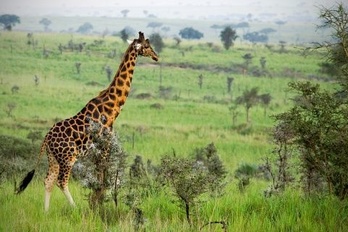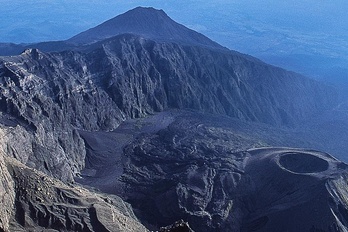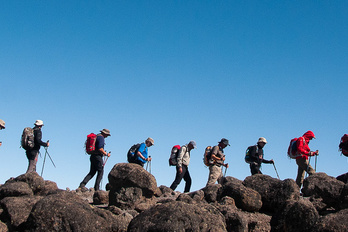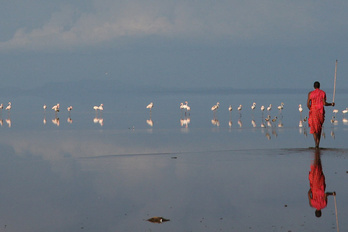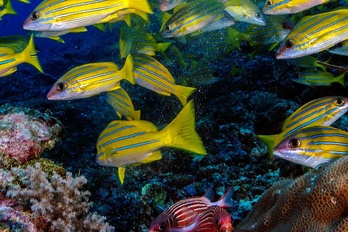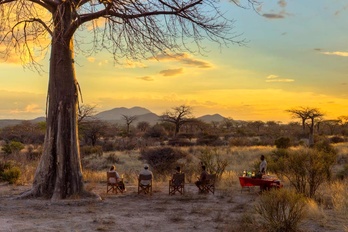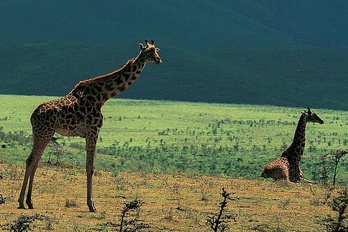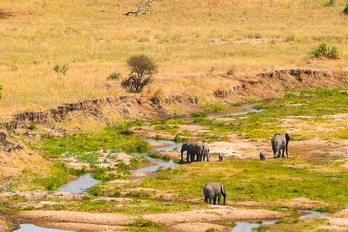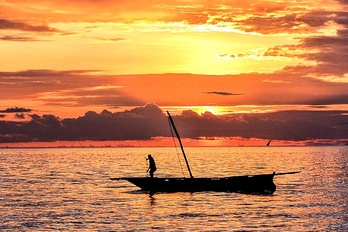TANZANIA KEYS FACTS
Administrative informations: Commonwealth Member
Capital: Dodoma
Area: 945,087 sq km (364,900 sq miles).
Population: 48.3 million (2013).
Population density:
51.1 per sq km.
Language: Kiswahili and English are the official
languages. The terms Swahili and Kiswahili are used interchangeably,
though the term Swahili normally refers to the people while Kiswahili
refers to the language. Originating along the coast, Kiswahili is a
Bantu language with many words derived from Arabic. Other African
languages such as Bantu and those of Nilo-Hamitic and Khoisan origin are
also spoken in more remote regions.
Religion: About
40-45% of Tanzania's population is Christian and about 35-40% are
Muslim (most of which live along the coast and on Zanzibar and the other
islands). A small number follow traditional religions and there are
some Asian communities including Sikhs and Hindus.
Political regime: Federal
Republic since 1964. Tanganyika gained independence from the UK in
1961. In 1964, Tanganyika joined with Zanzibar, which had been a British
protectorate until 1963, and became Tanzania
Head of state: President
Jakaya Kikwete since 2005. Zanzibar is semi-autonomous and has its own
parliament and president (President Ali Mohamed Shein since 2010Head of government: Prime Minister Mizengo Pinda since 2008.
SOCIAL & ECONOMICAL DATA
Tanzania's economy relies heavily on agriculture; the sector employs
around 80% of the working population and cash crops are one of the
country's main export earners, which accounts for nearly half of the
country's GDP. Mineral production (gold, diamonds and tanzanite) has
grown significantly in the last decade, and mining represents Tanzania's
biggest source of economic growth, provides over 3% of the GDP and
accounts for half of Tanzania's exports.
Coal, phosphates, gypsum, tin and other ores are also extracted.
Reserves of uranium, nickel, silver and natural gas have been located
and the mining sector is expected to be developed further to capitalise
on these resources. The industrial sector is one of the smallest in
Africa, concentrated in agricultural processing and light consumer goods
such as sugar processing, brewing and textiles. Tourism is thought to
be worth around US$950 million annually to the Tanzanian economy and
ranks as the second foreign exchange earner after agriculture.
On the whole, the economy has improved steadily since the mid-1990s. In
2006, Tanzania signed economic agreements with China for development
assistance in the communications, transport and health sectors and saw
the African Development Bank write off US$640 million of Tanzania's
foreign debt. More recently, with continued help from donor assistance
and a boost from an increase in gold exports, Tanzania's economy has
picked up the pace. GDP was a healthy 6.5% in 2010, with inflation
estimated to be around 7.2%.
TANZANIAN HISTORY
Tanzania is probably one of the oldest countries ever to be known
continuously inhabited areas on Earth; fossil remains of humans and
pre-human hominids have been found dating back over two million years.
About 2000 years ago, Bantu-speaking people began to arrive from western
Africa in a series of migrations. Later, Nilotic pastoralists arrived,
and continued to immigrate into the area through to the 18th century.
Travellers and merchants from the Persian Gulf and Western India have
visited the East African coast since early in the first millennium AD.
Islam was practised on the Swahili coast as early as the eighth or ninth
century AD. Claiming the coastal strip, Omani Sultan Seyyid Said moved
his capital to Zanzibar City in 1840. During this time, Zanzibar became
the center for the Arab slave trade.
In the late 19th century, Imperial Germany conquered the regions that
are now Tanzania (minus Zanzibar), Rwanda, and Burundi, and incorporated
them into German East Africa. During World War I, an invasion attempt
by the British was thwarted by German General Paul von Lettow-Vorbeck,
who then mounted a drawn out guerrilla campaign against the British. The
post-World War I accords and the League of Nations charter designated
the area a British Mandate, except for a small area in the northwest,
which was ceded to Belgium and later became Rwanda and Burundi. British
rule came to an end in 1961 after a relatively peaceful (compared with
neighbouring Kenya, for instance) transition to independence, with
Julius Nyerere as the first president. After the Zanzibar Revolution
overthrew the Arab regime in neighboring Zanzibar, which had become
independent in 1963, the island merged with mainland Tanganyika to form
the nation of Tanzania on 26 April 1964. Nyerere set up one-party rule.
The communist bloc powers of China, East Germany and the USSR
established friendly relations with the new regime. Corruption was
rampant.
Years of socialism left the country as one of the poorest, the least
developed and the most aid-dependent in the world. From the mid 1980s,
the regime financed itself by borrowing from the International Monetary
Fund and underwent some reforms. From the mid 1980s Tanzania's GDP per
capita has grown and poverty has been reduced and tourism has risen to
proportions which are becoming almost beyond sustainability.
TANZANIAN GEOGRAPHY
The United Republic of Tanzania lies on the east coast of Africa and is
bordered by Kenya and Uganda to the north; by Burundi, Rwanda and the
Democratic Republic of Congo to the west; by the Indian Ocean to the
east; and by Zambia, Malawi and Mozambique to the south. The Tanzanian
mainland is divided into several clearly defined regions: the coastal
plains, which vary in width from 16 to 64km (10 to 39 miles) and have
lush, tropical vegetation; the Maasai Steppe in the north, 213 to 1,067m
(698 to 3,500ft) above sea level, which gives rise to two prominent
mountains, Kilimanjaro, 5,895m (19,341ft) above sea level and Africa's
highest peak, and Mount Meru, 4,565m (14,973ft); and there's a high
plateau known as the Southern Highlands in the southern area towards
Zambia and Lake Malawi.
Savannah and bush cover over half the country, and semi-desert accounts
for the remaining land area, with the exception of the coastal plains.
Over 53,000 sq km (20,463 sq miles) is inland water, mostly lakes formed
in the Rift Valley and Tanzania's share of Lake Victoria and Lake
Tanganyika, both on its western border. Lake Victoria covers 69,490 sq
km (26,832 sq miles), which is Africa's largest lake and 49% of it lies
in Tanzania. With maximum depths of 1,470m (4,821ft), Lake Tanganyika is
estimated to be the deepest lake in Africa and is 673km (420 miles)
long and averages 50km (31 miles) across; 41% of its area lies in
Tanzania. The United Republic of Tanzania includes the islands of
Zanzibar and Pemba, about 45km (28 miles) off the coast to the northeast
of the country.
The Engaresero village on the Western shores of Lake Natron has been
chosen by the government of Tanzania to exemplify the Maasai pastoral
system given its singularity, integrity, high diversity of habitats and
biodiversity. The site also has major additional significance, because
of the presence of Lake Natron and the volcano Ol Doinyo Lengai, which
have immense ecological, geological and cultural value. The community
has demonstrated a strong resilience in facing threats to their systems,
and has maintained associated social and cultural institutions, which
ensure its sustainability under prevailing environmental conditions.
PEOPLE, CULTURES & TRADITIONS
When meeting and parting, hands are always shaken; this applies
throughout the country in both rural and urban areas. It is the
convention to use the right hand, not the left, to shake hands or pass
or receive anything. The standard greeting of 'hello' is jambo. People
are delighted if visitors can greet them in Kiswahili. Dress is on the
whole casual but a smart appearance for formal occasions such as an
upmarket restaurant is always appreciated.
Because of its Muslim influence, the coast is a little more
conservative, and away from the beach it is advised to dress respectably
and cover up bare arms and legs. Alcohol is only available in the
tourist areas on Zanzibar, where it is also considered highly impolite
to eat, drink or smoke in public during daylight hours when people are
fasting during Ramadan (the exception to this is in the tourist hotels
and restaurants).
